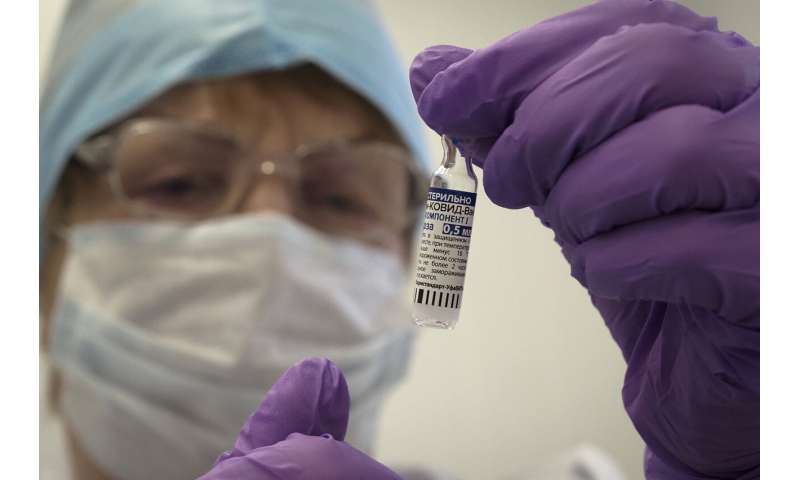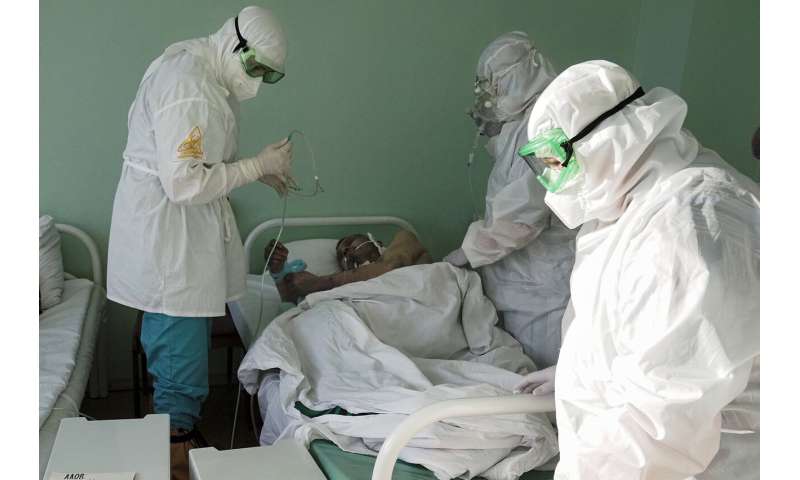
Maria Piparinen and other elderly residents of Ikhala were relieved when they heard that doctors were finally bringing a few doses of the coronavirus vaccine to their remote, snowy village in the Russian region of Karelia, near the border with Finland.
Otherwise, the 75-year-old said she would have had to hire a car to take her 10 kilometers (6 miles) to the town of Lakhdenpokhya, because the bus no longer runs there.
And besides, “I called the clinic in Lakhdenpokhya, but … they told me (all the slots in) February were booked already,” Piparinen told The Associated Press.
The village of wooden houses—carved out of a dense forest of fir trees about 20 kilometers (12 miles) from the Finnish border and 100 kilometers (60 miles) north of St. Petersburg—is one of several in the Karelia region where Russia’s vaccination campaign has arrived in recent weeks.
More than 18,000 people have gotten their first dose of the Sputnik V vaccine in the region of 600,000 that was hit hard by COVID-19.
At one point in December, Karelia recorded a daily average of 75.7 cases per 100,000 people, the highest rate in Russia as a whole, which had been averaging 18.8 recorded cases per 100,000.
“When you watch TV and see how people are suffering … you don’t want that. You want to live a little longer,” said 74-year-old Galina Shilova, one of Ikhala’s nearly 700 residents. Some of those getting the shots last week at the makeshift clinic had to make their way cautiously along snowy footpaths.

The goal is to vaccinate 290,000 people, or 60% of the region’s adults, by summer, said Karelia Deputy Health Minister Galina Matveyeva.
Russia took pride in being the first country to approve a coronavirus vaccine, although it faced criticism for doing it before completing the advanced testing necessary to ensure Sputnik V’s safety and effectiveness. It began vaccinations in December, another global first, but now lags behind a dozen nations that have been using vaccines developed in the West and China.
Russian authorities don’t regularly release data on vaccination rates, but the number who have gotten at least the first shot appears to be somewhere between 2 million and 3.2 million.
On Feb. 10, Denis Logunov, deputy director of the Gamaleya Center that developed Sputnik V, said 2.2 million Russians, or less than 2%, had received their first dose of the two-shot vaccine and more than 1.7 million had gotten both shots. An analysis of regional media reports by AP found that some 3.2 million had gotten their first shot as of last week.

That compares with over 43 million people in the U.S., or about 13.2%, who have gotten their first shot, and 18.8 million who have gotten both in a campaign that has had its own difficulties.
Russia’s slow rollout has raised questions in the West as more countries have agreed to buy millions of doses of Sputnik V.
The Russian Direct Investment Fund that bankrolled the vaccine’s development and is marketing it abroad didn’t respond to a request for comment on how many doses are going to other countries.
Media reports indicate about 20 countries ordered a total of over 200 million doses, said Elena Subbotina, consultant with Central & Eastern European Team of CBPartners, a global health care strategy consulting firm.
On Friday, an African Union-created task force said Russia has offered 300 million doses of Sputnik V.

“I must say we still wonder why Russia is offering theoretically millions and millions of doses while not sufficiently progressing in vaccinating their own people,” said European Commission President Ursula von der Leyen on Feb. 17.
Kremlin spokesman Dmitry Peskov said Russia’s vaccination campaign is going at “normal” rates.
The drive has picked up speed but is still rather slow, said Alexander Dragan, an independent data analyst who monitors regional vaccination rates.
“Between the beginning of January and now, the vaccination rate has increased 10 times. During the New Year holidays, some 13,000 people a day were being vaccinated, and over the past nine days, I estimate that shots were being given to 135,000-145,000 people daily,” Dragan said. “In absolute numbers, it looks impressive … but in proportionate numbers, it’s very modest, because one should keep in mind Russia’s population of 146 million.”

Dragan’s estimate suggests the vaccination rate last week was about one-fourth of that in the U.S.
Health Minister Mikhail Murashko has announced plans to vaccinate 60% of the population by the end of June.
Experts and the media point to limited supply, distribution logistics complicated by its having to be stored and transported at minus-18 degrees C (minus-0.4 F), and hesitance among those wary of its rushed approval.
“It’s supply-side or demand-side issues, and my guess is, it’s a little of both,” said Judy Twigg, a professor of political science at Virginia Commonwealth University specializing in global health.
Logunov, of the Gamaleya Center, said 7 million doses have been released for domestic use, another 1 million are expected by the end of February, and 10 million are planned to be produced in March.

The Health Ministry allocates the doses. While Muscovites can get vaccinated on the day they decide to do it, long waits have been reported in other regions.
In Karelia’s capital of Petrozavodsk, patients told AP they waited more than two weeks. Residents of Sortavala, a town about 300 kilometers (185 miles) west of Petrozavodsk, complained on social media in early February about being unable to sign up.
Regulations state that vaccines must be administered by a team including a physician to examine recipients and offer help in case of an adverse reaction—something that can also constrain the drive because of a limited number of available physicians.
Karelia has received 23,392 doses in total, 4,200 of which arrived last week. Matveyeva, the deputy health minister, said the region can store about 30,000 doses at once at minus-18 degrees C, limiting how many vaccines they can receive.

For last week, 250 doses were allocated to the Sortavala district and the neighboring district, an area that is home to 42,000 people, including those in Ikhala. A team led by Dr. Alexander Romanov, Sortavala hospital head, brought 10 doses to Ikhala on Tuesday.
When the outbreak surged in the fall, it didn’t spare Ikhala, where 60 infections were registered.
“November, December, January—it was something,” said Tatyana Tikhonova, the village paramedic.
Hamlets in Karelia, some of which became part of the Soviet Union after it fought a war with Finland in 1939-40, might appear to be cut off from more populated parts of Russia but actually are connected.
“Residents have relatives that work in cities and come to visit their parents, grandmothers and grandfathers on weekends and holidays, bringing the coronavirus with them,” said Dr. Irina Garmina of the Sortavala hospital.








Tikhonova told her patients when the doses were coming to Ikhala—mostly the elderly with conditions putting them at risk for the virus. One declined because she believed she had already had COVID-19 and didn’t want the vaccine without getting tested first.
Romanov acknowledged that “the number of vaccinated people is not high,” but is convinced more doses will arrive soon.
Source: Read Full Article



